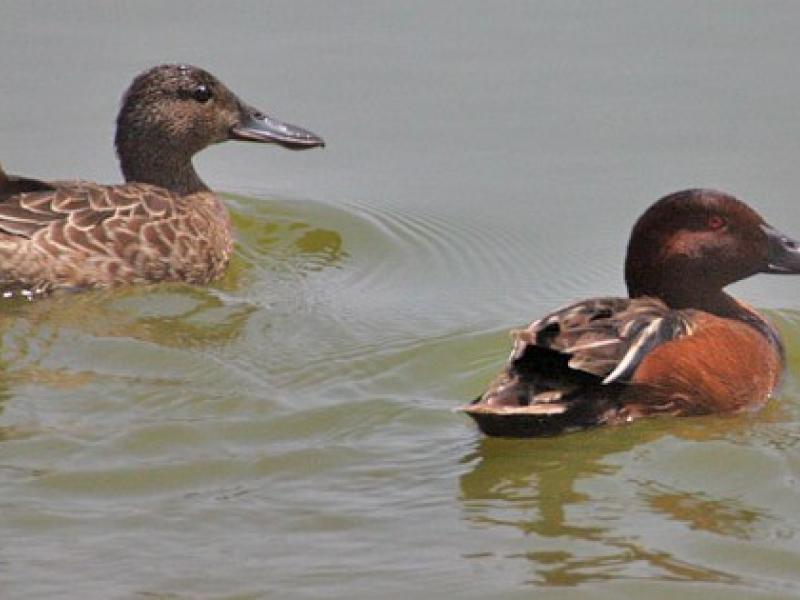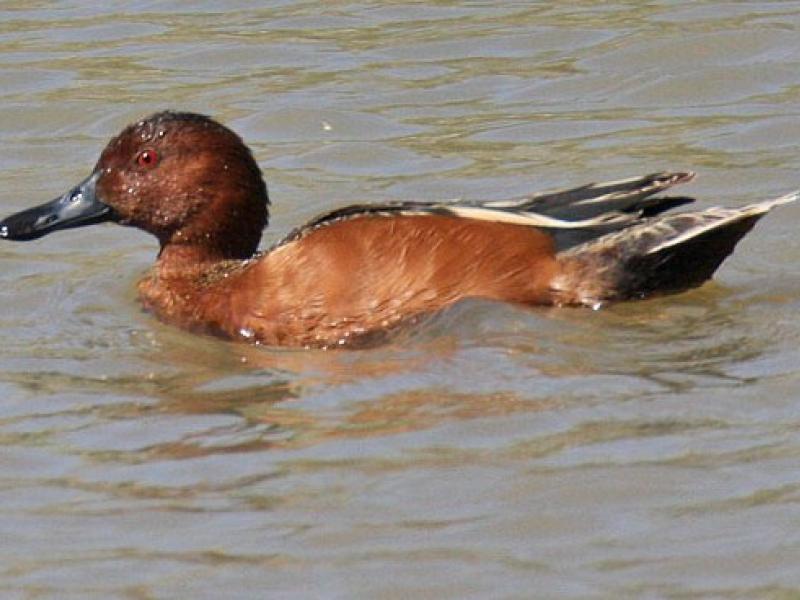Photo Credit: Glen Tepke
http://www.pbase.com/gtepke/
SCIENTIFIC NAME:
Anas cyanoptera
OTHER NAMES:
Sarcelle cannelle, cerceta castana, pato colorado.
STATUS:
Accidental.
DESCRIPTION:
Cinnamon teal are members of the “blue-winged” group of dabbling ducks, which includes blue-winged teal (A. discors), northern shoveler (A. clypeata), Cape shoveler (A. smithii), red shoveler (A. platalea), New Zealand shoveler (A. rhynchotis), and garganey (A. querquedula). There are five subspecies of cinnamon teal distributed across North, Central, and South America, with only one subspecies, the northern cinnamon teal (A. c. septentrionalium). Adult male cinnamon teal have a cinnamon-red head, neck, breast, and belly. They have an iridescent green speculum, separated from a bluish shoulder patch by a white stripe. The back, rump, upper tail coverts, and tail are dull brown and the under tail coverts are black. Males have a distinctive red eye, a black bill, yellow legs, and yellow feet. Females have a light brown head and neck, gray bill, and brown eyes. They have a brown breast and sides streaked with darker V-shaped spots. Their upper body parts are brown and their bellies are white. Juveniles are similar in appearance to adult females, having green speculums with white leading edges and pale blue upper secondary coverts. Males give a thin whistled "peep" or "peer”. Females have an infrequent quack similar to that of female northern shovelers, a weak “gack-gack-ga-ga”. Cinnamon teal are small, with an average length of 14-17 inches, an average wingspan of about 25 inches, and a body weight of approximately 12-14 ounces, being found primarily in North America.
DISTRIBUTION:
The majority of cinnamon teal breed in the western U.S. near the Great Salt Lake, Malheur Basin, San Luis Valley, and Cariboo-Chilcotin parklands, with some breeding also occurring in southern British Columbia, southern Alberta, southwestern Saskatchewan, southern and western Idaho, Montana, Wyoming, northern Arizona, most of New Mexico, and northwestern Texas. Unlike most North American dabbling ducks, cinnamon teal rarely breed in the midcontinent prairie-parkland region. The majority of cinnamon teal winter in Mexico and Central America, but large concentrations can also be found in the San Joaquin Valley of California. Cinnamon teal occasionally are seen in the midwestern and eastern U.S., usually in association with flocks of blue-winged teal.
HABITAT:
Cinnamon teal prefer shallow ponds, marshes, and lakes with alkaline water, bordered by low herbaceous growth. They appear to prefer basins with well-developed stands of emergent vegetation.
FEEDING HABITS:
Cinnamon teal are omnivorous, dabbling ducks. They feed on aquatic plants in shallow water areas, especially rush seeds, pondweed seeds and leaves, and salt grass seeds. They also feed on animal food, especially aquatic insects and mollusks.
LIFE HISTORY AND ECOLOGY:
Mating pair bonds are renewed each season while on the wintering grounds. Males typically abandon their mates by the third week of incubation. Mating and nesting occurs from mid-spring through mid-summer. The cinnamon teal hen constructs a half-moon shaped nest out of plant stems and dead grass. Nests are sometimes built underneath dead reeds and plant stems. This conceals the nests from the sides and from above. Hens enter the covered nests through a tunnel in the plant material. Nests often are located in grassy areas and island nesting is common. Female cinnamon teal lay one clutch of eggs annually, with an average of eight to ten off-white to pale buffy eggs per clutch. Incubation lasts twenty-one to twenty-five days. Newly hatched ducklings are covered with down, leave the nest within 24 hours of hatching, and travel with the hen to a nearby water source. The ducklings are able to feed themselves from the first day they hatch, but remain under the care of the hen until fledging at approximately seven weeks old. The eyes of the young drakes become red at eight weeks of age. Sexual maturity is reached after one year. Cinnamon teal migrate early in the fall and as a result, are not heavily harvested by hunters in the U.S. and Canada.
REFERENCES:
Cadwell, M. 2002. Anas cyanoptera. Animal Diversity Web. https://animaldiversity.org/accounts/Anas_cyanoptera/.
Gammonley, James H. 1996. Cinnamon Teal (Anas cyanoptera), The Birds of North America Online (A. Poole, Ed.). Ithaca: Cornell Lab of Ornithology; Retrieved from the Birds of North America Online: https://birdsoftheworld.org/bow/species/cintea/cur/introduction
http://www.birdweb.org/birdweb/bird_details.aspx?id=70
https://www.mbr-pwrc.usgs.gov/id/framlst/framlst.shtml
http://www.nhptv.org/NatureWorks/cinnamonteal.htm
National Geographic Society. 1999. Field guide to the birds of North America, third edition. National Geographic Society, Washington, D.C. 480 pp.
Peterson, R.T. 1980. A field guide to the birds of eastern and central North America, fourth edition. Houghton Mifflin Company, Boston, Massachusetts. 384 pp.
AUTHOR:
Chris Cook, Wildlife Biologist, Alabama Division of Wildlife and Freshwater Fisheries







